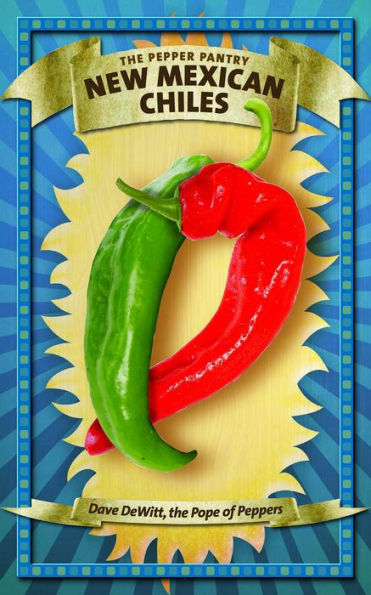

eBook
Available on Compatible NOOK devices, the free NOOK App and in My Digital Library.
Related collections and offers
Overview

Product Details
| ISBN-13: | 9781948749381 |
|---|---|
| Publisher: | Terra Nova Books |
| Publication date: | 11/12/2018 |
| Sold by: | Barnes & Noble |
| Format: | eBook |
| File size: | 3 MB |
About the Author
Read an Excerpt
According to many accounts, chile peppers were introduced into what is now the U.S. from Mexico by Capitn General Juan de Oate, the founder of Santa Fe, in 1598. However, they may have been introduced to the Pueblo Indians of New Mexico by the Antonio Espejo expedition of 1582-83. According to one member of the expedition, Baltasar Obregn, They have no chile, but the natives were given some seed to plant. By 1601, chiles were on the list of Indian crops, according to colonist Francisco de Valverde, who also complained that mice were a pest that ate chile pods off the plants in the field. A la primera cocinera se le va un chile entero, goes one old Spanish dicho, or saying: To the best lady cook goes the whole chile. And so it is that the chile pepper is the single most important food brought from Mexico that defines New Mexican cuisine. After the Spanish began settlement, the cultivation of chile peppers exploded, and soon, they were grown all over New Mexico. It is likely that many varieties were cultivated, including early forms of jalapeos, serranos, poblanos, and pasillas. But one variety that adapted particularly well to New Mexico was a long green chile that turned red in the fall. Formerly called Anaheim because of its transfer to more-settled California around 1900, the New Mexican chiles were cultivated for hundreds of years in the region with such dedication that several distinct varieties developed. These varieties, or landraces, called Chimay and Espaola, had adapted to particular environments and are still planted in the fields they were grown in centuries ago; they constitute a small but distinct part of the tons of pods produced each year in New Mexico. In 1846, William Emory, chief engineer of the U.S. Armys Topographic Unit, was surveying the New Mexico landscape and its customs. He described this meal eaten in Bernalillo, just north of Albuquerque: Roast chicken, stuffed with onions; then mutton, boiled with onions; then followed various other dishes, all dressed with the everlasting onion; and the whole terminated by chile, the glory of New Mexico. Emory went on to relate his experience: Chile the Mexicans consider the chef-doeuvre of the cuisine, and seem really to revel in it; but the first mouthful brought the tears trickling down my cheeks, very much to the amusement of the spectators with their leather-lined throats. It was red pepper, stuffed with minced meat.
Table of Contents
Introduction 1
Part 1 "Anaheim" and Ail the Rest of Them 3
Nomenclature 5
Chile History 5
Varieties 7
Heat Scale 8
Part 2 From Seed to Shelf 9
Botanical Description 11
Cultivation and Preservation 11
The Strategy 11
Starting Seeds 12
Pests 13
Transplanting 13
Preparing the Plot 14
The Growing Season 16
Harvest Time 17
Roasting and Peeling the Pods 18
Preserving the Crop 21
Drying Chiles 22
Making Ristras 22
Other Drying Methods 24
Making Powders 25
Chile Pasado 27
Part 3 Red and Green in the Kitchen 29
Culinary Usage 31
Sauces, Salsas, and Dressings 33
Green Chile Sauce 35
Dave's Fresh Red Chile Sauce 36
Classic New Mexican Red Chile Sauce 37
Salsa Fresca with Green Chile 38
Southwest Seasoning Rub 39
Appetizers and Breakfast 41
The Ultimate Chilehead Guacamole 43
Disappearing Chile Strips 45
Sweet Potato Chips Dusted with Chimayó Red Chile 46
Hot Shot Olives 47
Huevos Rancheros de Nuevo Mexico (New Mexican Ranch-Style Eggs) 48
Southwest Breakfast Burritos 49
Soups and Salads 51
Sopa de Lima 53
Green Chile Stew 54
Posole with Chile Caribe 56
Chile con Carne with Frozen Red or Green Chile 58
Jicamella and Orange Salad 59
Green Chile Panzanella (SouthwestoStyle Tuscan Bread Salad 60
Succulent Southwest Potato Salad 62
Main Dishes 63
Grilled Piñon Lamb Chops 65
Perfect Santa Fe Enchiladas 66
New Mexico Carne Adovada 68
Roulade of Pork with Green Chile and Cilantro 69
Stuffed Chicken Breasts with Walnut Pipián Sauce 71
Tamale Pie with Cheese and Chicken 73
Side Dishes 59
Calabacitas con Chile Verdes (Squash and Green Chile) 76
Chiles Rellenos 77
Papas con Chile Colorado (Potatoes with Red Chile) 79
A Drink and a Dessert 81
Bloody Maria 83
The Honorabel Biscochito from the Land of Enchantment 84
Part 4 Resources 87
Further Reading 89
Seed and Plant Sources 89
Websites 89
Chile Pepper Suppliers and Online Hotshops 90
About the Author 91
